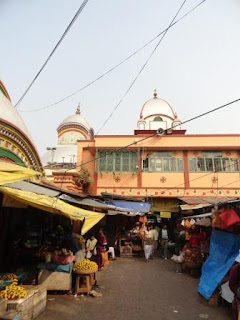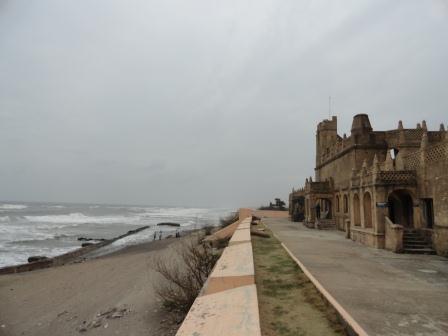It was only after I boarded the flight to Kolkata that I realised that the 150th Birth anniversary of Swami Vivekanada falls on that day(12 Jan 2013). Considering that the Swami was a hero from childhood, I considered a good omen that I am at his birth place for the first time on such an auspicious occasion. But since I was travelling to Kharagpur that day, I was back in Kolkata only the next day.
On arriving at Kolkata, I hired one of the several yellow taxis(mostly Ambassador cars) that ply in Kolkata. The taxi driver was an immigrant from nearby Bihar and he was my guide for the rest of the day.
Quite interestingly, the first place he took me to was Swami Vivekananda's birth place in Kolkata, where he lived till he became a monk.
The driver told me that the whole city was out on the roads celebrating Swami's birth day. I could see posters of Swami on both sides of the road everywhere I went.
The posters of another Bengali hero, Subhas Chandra Bose, could also be seen everywhere. The only other person whose pictures outnumbered these two was that of the Chief Minister, Mamta Banerjee.
From there, we proceeded towards Howrah bridge or Rabindra Sethu, which is one of the most famous landmarks of Kolkata. The bridge, commissioned in 1943 by the British, is a suspension bridge over which more than 100,000 vehicles are estimated to ply every day.
The Vidyasagar bridge, which was commissioned almost 50 years later in 1992, runs along the same Hooghly river and is the longest cable stayed bridge in India.
We stopped for some time at one of the ghats(steps leading to the river), on the Hooghly river, which is a distributary of river Ganges. Some of the people there were taking a dip to honour some of their dead near and dear, some where shaving their head as a ritual and some others were idling around.
The last stop before lunch was Kalighat temple, which is estimated to be more than 200 years old and is thronged by devotees. It is located at one of the oldest parts of the city and the streets leading to it was quite narrow, with lot of vendors selling anything from pooja items to framed pictures of the Goddess.
Just as we looking to park the car, 2-3 people who claimed to be priests of the temple surrounded me and offered to take me inside the temple and do a pooja within 10 minutes, for just Rs. 51. Not very enthused by the stalking, I returned without entering the temple.
Lunch was at Halidram, one of the famous food chains and famous for selling sweets. This was my opportunity to taste the famous Bengali sweets. One of my friends had suggested that I should try a sweet called Sandesh, which, along with Rasagolla and Mishti Doi, is one of the most sought after sweets. Unlike Rasagolla, which lasts for long when packed properly and is available anywhere in the country, Sandesh has to be consumed within hours of preparation. Since it does not have a long shelf life, it is typically not available is most other parts of the country. Haldiram had at least 5 varieties of Sandesh, which made my job quite difficult in choosing the right one. I tried two of them and got the rest packed and took them back home.
Post lunch session started with a visit to Victoria Memorial, easily the most sought after tourist location in Kolkata. Enroute to Victoria Memorial, we crossed by some other places like Alipore Zoo, the historic Alipore Jail(where Subhas Chandra Bose was an inmate), the small Gali/street where the Chief Minister, Mamta Banerjee lives and some old buildings.
Victoria Memorial, as the name suggests, was built in the memory of Queen Victoria of England and was commissioned in 1906. It resembles some of the grand palaces in Europe and has a museum and several art galleries. The building premises was filled with crowd, who had come to spend their Sunday evening at this lovely place.
The picture above does not do justice to the beauty of the building and I suggest you to take a look at this picture to appreciate it(Click here).
The last stop would be Dalhousie square, which is the part of the city with several historic buildings from the British era. Enroute, we passed the Eden gardens or the Mecca of Indian cricket.
The Writer's building, which is the secretariat of the the West Bengal Government lies in the vicinity of the Dalhousie square.
Other historic buildings include the Calcutta High Court, Raj Bhavan, St. Paul's Cathedral and the General Post Office(GPO) among others. The picture of GPO is given below.
By now, it was evening and I had the flight to catch. I still haven't visited several other places, including the Belur Matt, Marble palace, Kali temple at Dakshishwar, Mother Teresa's Missionaries of Charity. That would be for the next trip. Before that, I should read the famous book by Dominique Lapierre '' City of Joy''. Now, back to Chennai!!
On arriving at Kolkata, I hired one of the several yellow taxis(mostly Ambassador cars) that ply in Kolkata. The taxi driver was an immigrant from nearby Bihar and he was my guide for the rest of the day.
Quite interestingly, the first place he took me to was Swami Vivekananda's birth place in Kolkata, where he lived till he became a monk.
The driver told me that the whole city was out on the roads celebrating Swami's birth day. I could see posters of Swami on both sides of the road everywhere I went.
The posters of another Bengali hero, Subhas Chandra Bose, could also be seen everywhere. The only other person whose pictures outnumbered these two was that of the Chief Minister, Mamta Banerjee.
From there, we proceeded towards Howrah bridge or Rabindra Sethu, which is one of the most famous landmarks of Kolkata. The bridge, commissioned in 1943 by the British, is a suspension bridge over which more than 100,000 vehicles are estimated to ply every day.
The Vidyasagar bridge, which was commissioned almost 50 years later in 1992, runs along the same Hooghly river and is the longest cable stayed bridge in India.
We stopped for some time at one of the ghats(steps leading to the river), on the Hooghly river, which is a distributary of river Ganges. Some of the people there were taking a dip to honour some of their dead near and dear, some where shaving their head as a ritual and some others were idling around.
The last stop before lunch was Kalighat temple, which is estimated to be more than 200 years old and is thronged by devotees. It is located at one of the oldest parts of the city and the streets leading to it was quite narrow, with lot of vendors selling anything from pooja items to framed pictures of the Goddess.
Just as we looking to park the car, 2-3 people who claimed to be priests of the temple surrounded me and offered to take me inside the temple and do a pooja within 10 minutes, for just Rs. 51. Not very enthused by the stalking, I returned without entering the temple.
Lunch was at Halidram, one of the famous food chains and famous for selling sweets. This was my opportunity to taste the famous Bengali sweets. One of my friends had suggested that I should try a sweet called Sandesh, which, along with Rasagolla and Mishti Doi, is one of the most sought after sweets. Unlike Rasagolla, which lasts for long when packed properly and is available anywhere in the country, Sandesh has to be consumed within hours of preparation. Since it does not have a long shelf life, it is typically not available is most other parts of the country. Haldiram had at least 5 varieties of Sandesh, which made my job quite difficult in choosing the right one. I tried two of them and got the rest packed and took them back home.
Post lunch session started with a visit to Victoria Memorial, easily the most sought after tourist location in Kolkata. Enroute to Victoria Memorial, we crossed by some other places like Alipore Zoo, the historic Alipore Jail(where Subhas Chandra Bose was an inmate), the small Gali/street where the Chief Minister, Mamta Banerjee lives and some old buildings.
Victoria Memorial, as the name suggests, was built in the memory of Queen Victoria of England and was commissioned in 1906. It resembles some of the grand palaces in Europe and has a museum and several art galleries. The building premises was filled with crowd, who had come to spend their Sunday evening at this lovely place.
The picture above does not do justice to the beauty of the building and I suggest you to take a look at this picture to appreciate it(Click here).
The last stop would be Dalhousie square, which is the part of the city with several historic buildings from the British era. Enroute, we passed the Eden gardens or the Mecca of Indian cricket.
The Writer's building, which is the secretariat of the the West Bengal Government lies in the vicinity of the Dalhousie square.
Other historic buildings include the Calcutta High Court, Raj Bhavan, St. Paul's Cathedral and the General Post Office(GPO) among others. The picture of GPO is given below.
By now, it was evening and I had the flight to catch. I still haven't visited several other places, including the Belur Matt, Marble palace, Kali temple at Dakshishwar, Mother Teresa's Missionaries of Charity. That would be for the next trip. Before that, I should read the famous book by Dominique Lapierre '' City of Joy''. Now, back to Chennai!!




























